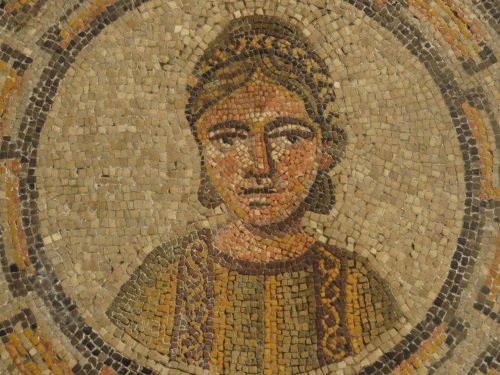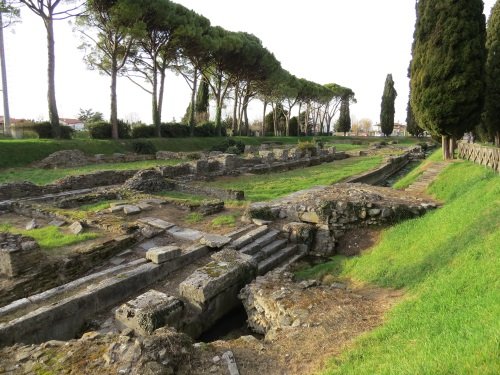Aquileia
is a town in the far northeast of Italy, situated between Venice and Trieste. This frontier location is what made it into a WHS as well: founded as a Latin colony in 181 BC, it rose to a respectable position as Adriatic port, trading centre and seat of a patriarchate whose territory extended to large parts of modern Austria, Slovenia, and Croatia. Aquileia had 100,000 inhabitants in the 2nd century AD – today there are only 3,500 and the town has fallen almost into oblivion.

|
|
The Basilica, with the apse covered in frescoes
|
I arrived in Aquileia on a bright sunny Saturday afternoon – the town would be my base for 4 days in the wider Venice region. Originally I had booked a hotel in Cervignano, but I cancelled it a week ago – a good choice so it seemed, as Cervignano appeared to be nothing more than a sleepy transport hub when I passed through it getting off the train from Venezia Mestre. Aquileia is much nicer: very compact, and just touristy enough to have several restaurants and frequent bus links within the region.
The WHS encompasses the whole town center, but the focus is on the Patriarchal Basilica and the Early Roman ruins. The Basilica’s tower can be seen from afar, it is the landmark of Aquileia. I started my sightseeing here at the Patriarchial Complex. I bought my ticket at the Baptistery: for 9 EUR you receive a combination ticket that gives access to all parts of the complex. The octagonal Baptistery lies across from the main church. It has its floor mosaics, and there are re-used pagan sarcophagi on display. Both date from the 4th and 5th century.
This is only an appetizer for what is on show in the Basilica itself. There the floor is fully covered in mosaics (37x20m!). Visitors walk a meter or so above it on a plexiglass cover. Not surprisingly for a port there are many marine scenes: fish, fishermen and octopus are all immortalized in mosaic. But there are also ‘portraits’ of recognizable human beings, possibly of donors. Twice I noticed a depiction of the struggle between a cock and a tortoise, symbolizing Christianity versus paganism.

|
|
Portrait mosaic on the Basilica's floor
|
At either side of the Basilica lies a crypt. The one at the far end is the Crypt of the Frescoes. It has colourful 12th century murals on its walls and vaults. Part of it is under restoration at the moment, but you can still see most of the frescoes. They illustrate the lives of Saint Mark and Saint Hermagora, the latter being the first bishop of Aquileia. The crypt to the left of the entrance is called the Crypt of the Excavations. These actually are the excavations of a corridor, with more mosaics and some visible parts of a Roman villa.
After spending an hour in and around the Basilica, I walked on along Aquileia’s main street to the Roman ruins. These comprise several locations within a few minutes walk from each other. There’s no entrance fee, but the sites are fenced off and signage tells that they close at 4 p.m. in winter. The gates were open until at least an hour after that fortunately, otherwise my visit would have been very short. While there is nothing mindblowing to see, three of the excavations stand out in my opinion. The Forum has one row of capitols left, which picturesquely stand out against the Basilica’s Tower. Across the street lies a large mausoleum from the 1st century AD, which was found a few kilometer outside Aquileia.
Most typical for Aquileia however are the remains of the ancient port. They’ve created a nice shady path for a stroll along the river (now a mere ditch). The silhouettes of warehouses and quays are easily discernable. A few information panels give some background story, but it is hard to imagine the hustle and bustle that was going on here over 2,000 years ago.

|
|
Ruins of the ancient port
|
Although Aquileia is surely worth a detour, I would not rate its Early Christian / Byzantine features as high as
Ravenna
(the WHS to which it is often compared). The mosaic floor is great, but especially the frescoes in the Crypt disappointed me. And you wouldn’t surely come here for the Roman archaeogical site alone, of which there are many better preserved examples in the Mediterranean. I had been reading the (rather long and repetitive) book
SPQR
on the plane and in the train on my way to Aquileia. It now and then touches on the plight of ‘Latin colonies’ such as Aquileia – outposts loosely linked to Rome, inhabited by non-Roman citizens (at least until the year 90 BC). After finishing the book and this visit I am left somewhat but not a whole lot wiser regarding this subject.



